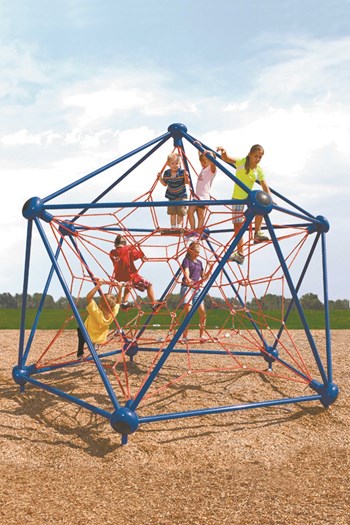
Back in the day when most of us were little kids, playgrounds largely consisted of swing-sets, teeter-totters, some monkey bars, and maybe a metal slide or two, along with the requisite basketball hoops and tetherball set-up.
Since then, playground equipment has come a very long way—gone are the colorless pieces of welded metal set up in merciless black asphalt. Kids today get to play on all kinds of cool, interactive equipment, and if they happen to take a spill, chances are their fall will be broken by several inches of industrial-grade foam padding instead of concrete or pea-gravel.
Swing Shift
Starting in the 1980s, playground equipment began to shift away from plain metal and asphalt to the more colorful, user-friendly options you see on the market today.
“The play equipment we grew up on (50 and older) started to be phased out when ‘Play Structures’ were developed in the mid-1980s,” says George J. Herberger, CPSI, the vice president of Ben Shaffer & Associates, a Lake Hopatcong-based company that represents manufacturers of park and playground equipment. “Asphalt surfacing was phased out in the early 1990s due to falls on the surface being the most common cause of injuries on playgrounds, approximately 70 percent.”
Industry experts say that the concept of continuous play, plus advances in materials and technology in the 1980s and 1990s led to a huge expansion in opportunities for commercial playground equipment. Another major change occurred in 1981 when, in light of numerous playground injuries such as children falling off of teeter-totters, slides and monkey bars, led the Consumer Product Safety Commission (CPSC) to publish the first Handbook for Public Playground Safety, which was designed to provide guidelines for making playgrounds safer.
The Handbook remained largely the same until 2008, when the CPSC made several significant revisions. Age ranges were expanded to include children as young as six months, guidelines for track rides and log rolls were added, the critical height table revised and suggestions for surfacing over asphalt were added.
Another modification in playground construction occurred as a result of changes to the Americans with Disabilities Act (ADA) and the ability for children with special needs to play alongside children without disabilities.
“The original ADA standards went into effect in 1992 and were recently revised after 20 years,” says Kenneth Otten, a nationally recognized accessibility and ADA expert. “There were no specific requirements for playground equipment in the original version of the ASA Accessibility Guidelines for buildings and facilities. The only requirement was that an accessible route had to be provided to the boundary of the play area.”
Otten says that after much study, the Access Board incorporated new requirements for playground surfaces and equipment which became mandatory on March 15, 2012.
“Homeowners associations should be able to rely on the manufacturer's statement that their equipment complies with the new ADA standards,” says Otten. “However, it is best practice to consult with a local design professional and an ADA compliance specialist before designing a new playground, upgrading an older one and purchasing equipment.
Otten says there are other factors, in addition to the actual equipment, that must be considered, including the number and types of elevated and ground-level features, surface material under and on the route to the equipment (because surface material must meet both safety and accessibility requirements), and routes of travel to the playground area.
“Surfaces under playground equipment must meet safety requirements so that when a child falls, they fall on soft and safe material,” says Otten. “At the same time, the surface must also meet the requirements of the ADA to ensure that a wheelchair can successfully navigate to and between equipment. There are specialized materials that accomplish this; however they tend to be quite expensive.”
Most Popular
Each year the playground industry rolls out new and updated products to the marketplace that that allow children to twist and spin through tunnels, race down hilly slides, or even walk a tightrope. What hasn’t changed is that kids love to climb, swing, slide and bounce.
“The most popular playground items are broken down into climbers, overhead events and panels,” says Richard N. Hagelberg, CEO of the Gary, Indiana-based company Kidstuff Playsystems, which services numerous playgrounds throughout New Jersey. “It sort of depends on early childhood. Some people are very conservative in terms of what they’ll let their kids do. For example, there are a lot of climbers and over-headers but most pre-schools don’t want to have climbers because they are afraid the kids are going to fall and they are very protective of kids at that age. That’s less the case in elementary schools.”
Equipping a playground for the youngest common denominator isn't always the best route however, Hagelberg continues. “Kids need opportunities to be challenged, and sometimes they're missing out on the opportunity to do that if the equipment is scaled down to the point where it’s safe for two-year-olds - then a three-, four- or five-year-old is not going to be challenged. Parents need to give kids a chance to skin their knees. That’s how they learn things.”
“Swing and slides are always popular but climbing is becoming a lot more popular with kids—
climbing in the physical sense, challenge activities and obstacle course style activities are also extremely popular,” adds Dave Ely, vice president of George Ely Associates Inc., a company with offices in Swedesboro and Oakland that represents athletic, playground and skate park equipment. “Rock walls are a part of the whole climbing phenomenon that’s happening. Some of it is cable or wire rope-type of climbing. Some of it is non-linear type of climbing.”
Playing Safe
Industry experts agree that safety standards for playground equipment have radically changed over the past two decades.
“The Consumer Product Safety Commission’s first guidelines came out in 1981 and have been revised repeatedly over the years. This publication changed the play industry,” says Herberger. “New Jersey has incorporated this guideline into the NJ Uniform Construction Code via Public Law 1999 Chapter 50. Also the ASTM Standard #1487 is used by manufacturers to insure safe equipment is developed and tested. Many standards apply to playgrounds these days, equipment, surfacing, ADA access and fencing standards, to name a few.”
Several playground manufacturers believe that today’s safety standards have become so rigid that it actually impacts the design. “From a guideline and safety standpoint we’ve swung in such a direction that as manufacturers and designers we are pigeon-holed into designing certain ways because of the guidelines that there are no risks and challenges,” says Michael L. Parody, CPSI, who is the president of Massachusetts-based UltiPlay Parks & Playgrounds. “You want a playground that provides challenges and risks that will stretch your mental and physical capabilities. People will realize you can’t bubble wrap your kids and that it’s good to skin your knee every once in a while.”
Community Through Play
Playgrounds bring a sense of community to an association or HOA, and are a popular amenity that will boost property value and attract families. With this in mind, there are various ways for a community to go about choosing what equipment and vendors are the right fits for them.
“Contacting a playground company and having one of their local representatives come out and assess their needs is the first step a condo or co-op community should take if they are thinking about installing playground equipment,” says Ely. “They should also establish a budget and sometimes that can be difficult. Being aware of how much space they have is key because of the safety guidelines. We need to know what space they have to allow for the play equipment.”
Hagelberg agrees and says getting in touch with a playground distributor is the first step. “We would need to know what age group they are aiming this toward. Typically, there are playschool playgrounds for two- to five-year-olds and playgrounds for five-year-olds to 12-year-olds. We could do a playground for two-year-olds to 12-year-olds but that would take away the challenge for the older kids.”
All experts agreed that there are numerous benefits for a community playground.
“The HOA market is a competitive market so providing an inviting place to play is an advantage over other HOAs that don’t have such an area,” says Herberger. “Play is essential in providing well-balanced child development. Children using a playground have better social skills than children growing up without such areas to play in. Playgrounds in themselves become a social activity, providing members with a meeting place to learn about each other and make new friends.”
Lisa Iannucci is a freelance writer and a frequent contributor to The Cooperator. Staff writer Christy Smith-Sloman contributed to this article.






Leave a Comment